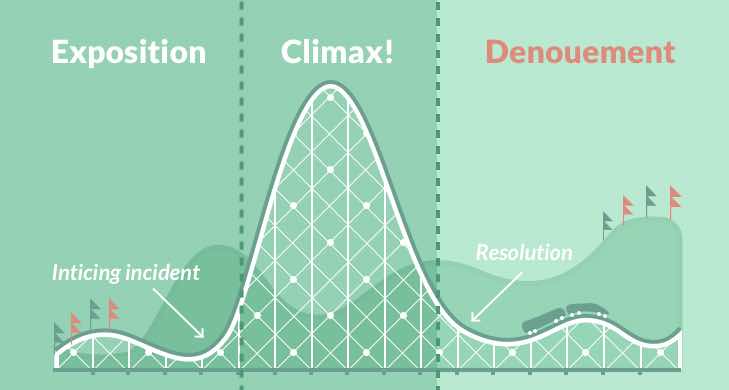What is needed to create a film?
- Director
- Actors
- Camera and Microphones
- Set/Scene/Location
- Producer
- Money
- Editing software
- Screenwriter/ Script
- Cameraman
- Script
Narrative structures and internal elements of creating a film :
- Chronological
- Linear
- Flashbacks/ Foreshadowing
- Ellipsis
- Parallel Narrative
- Protagonist
- Antagonist
- Character
- Conflict
- Exposition/Resolution
Freytag’s Pyramid
- Exposition = The background information on the characters and setting explained at the beginning of the story. Earlier events are alluded to.
- Climax = The point of highest intensity in a narrative. A story changing event takes place.
- Denouement = The final part of a play, film, or narrative in which the strands of the plot are drawn together and matters are explained or resolved.

Aristotle
- Catharsis
- Peripetia
- Anagnorisis
- 3 Unities : Time, Place, Action. The idea that a narrative should be consistent and should encompass the same place, time frame and plot/action.
Todorov
Often, most stories can be easily broken down into a BEGINNING / MIDDLE / END.
Todorov breaks this into a 3-part narrative structure:
- Equilibrium
- Disruption
- New equilibrium
Single character transformations are pursued = Traditional Todorovian stories place one lead hero at the centre of the narrative and secondary characters help them on their quest to the new equilibrium.
Frame stories = Stories told inside of stories, testing Todorov’s ideal structure.
Vladimir Propp
- Developed theories on character when analysing Russian folk tales in his 1929 book ‘Morphology of the Folktale’.
- Stock characters are used to structure stories, suggesting that the majority of stories use familiar character types to provide familiar narrative structures.
These stock characters are :
- Hero
- Helper
- Princess
- Villain
- Victim
- Dispatcher
- Father
- False Hero
- These characters are not always separate individuals as one character could occupy the different characteristics of a few.
- Propp also suggests that the different stock characters are often liked to a ‘sphere of action’ or a point in the narrative where their character traits and function is utilised and at the forefront of the story.
- He discovered that most narratives are based around the functions of the hero, villain and princess archetypes, he also found that the fairy tales he was studying were organised using a combination of just 31 moments in the plot called ‘narratemes’.
- “these are not separate characters, since one character can occupy a number of roles”
Claude Levi- Strauss
“myths (narratives) were used to deal with the contradictions in experience”
- NARRATIVES are STRUCTURED around BINARY OPPOSITIONS eg: good v evil; young v old etc.
- Narrative is simply a structure of key (oppositional) themes, creating a dominant message
- So in this way audiences are encouraged to make a judgements about characters, groups, places, history, society etc.
- However, the way in which audiences analyse or view these binary oppositions (if they notice them at all) is reflective of their own views and ideologies.
Seymour Chatman
There are two distinct parts to a story: The important plot moments and the embellishments added to create a populated narrative.
- Kernels = Key moments in the plot/ narrative structure.
- Satellites = Embellishments, developments, aesthetic that add “fluff”. These creative aspects are not essential to the storyline but enhance how it is consumed.
Roland Barthes
He came up with the ideology that narratives are often made up of action and thinking or talking about action. Barthes came up with two different codes to distinguish these.
- Proairetic code = Action, movement
- Hermenuetic code = Dialogue, character, reflection
Enigmas are puzzles that keep the audience engaged with the narrative. Enigma code is the way in which ideas are raised. How they keep the audience wanting more.
